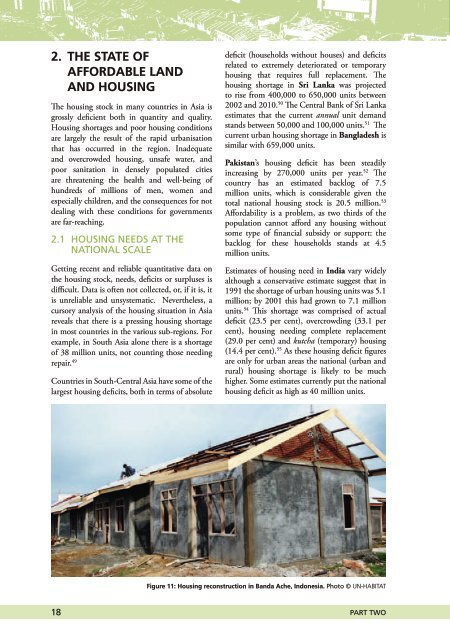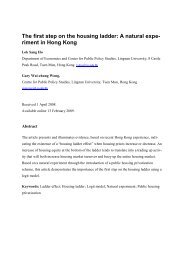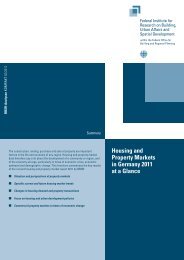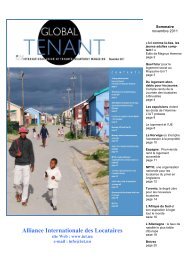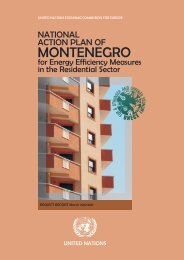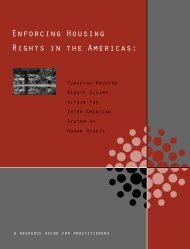2. THE STATE OFAFFORDABLE LANDAND HOUSINGThe <strong>hous<strong>in</strong>g</strong> stock <strong>in</strong> many countries <strong>in</strong> Asia isgrossly deficient both <strong>in</strong> quantity <strong>and</strong> quality.Hous<strong>in</strong>g shortages <strong>and</strong> poor <strong>hous<strong>in</strong>g</strong> conditionsare largely the result <strong>of</strong> the rapid urbanisationthat has occurred <strong>in</strong> the region. Inadequate<strong>and</strong> overcrowded <strong>hous<strong>in</strong>g</strong>, unsafe water, <strong>and</strong>poor sanitation <strong>in</strong> densely populated citiesare threaten<strong>in</strong>g the health <strong>and</strong> well-be<strong>in</strong>g <strong>of</strong>hundreds <strong>of</strong> millions <strong>of</strong> men, women <strong>and</strong>especially children, <strong>and</strong> the consequences for notdeal<strong>in</strong>g with these conditions for governmentsare far-reach<strong>in</strong>g.2.1 HOUSING NEEDS AT THENATIONAL SCALEGett<strong>in</strong>g recent <strong>and</strong> reliable quantitative data onthe <strong>hous<strong>in</strong>g</strong> stock, needs, deficits or surpluses isdifficult. Data is <strong>of</strong>ten not collected, or, if it is, itis unreliable <strong>and</strong> unsystematic. Nevertheless, acursory analysis <strong>of</strong> the <strong>hous<strong>in</strong>g</strong> situation <strong>in</strong> Asiareveals that there is a press<strong>in</strong>g <strong>hous<strong>in</strong>g</strong> shortage<strong>in</strong> most countries <strong>in</strong> the various sub-regions. Forexample, <strong>in</strong> South Asia alone there is a shortage<strong>of</strong> 38 million units, not count<strong>in</strong>g those need<strong>in</strong>grepair. 49Countries <strong>in</strong> South-Central Asia have some <strong>of</strong> thelargest <strong>hous<strong>in</strong>g</strong> deficits, both <strong>in</strong> terms <strong>of</strong> absolutedeficit (households without houses) <strong>and</strong> deficitsrelated to extremely deteriorated or temporary<strong>hous<strong>in</strong>g</strong> that requires full replacement. The<strong>hous<strong>in</strong>g</strong> shortage <strong>in</strong> Sri Lanka was projectedto rise from 400,000 to 650,000 units between2002 <strong>and</strong> 2010. 50 The Central Bank <strong>of</strong> Sri Lankaestimates that the current annual unit dem<strong>and</strong>st<strong>and</strong>s between 50,000 <strong>and</strong> 100,000 units. 51 Thecurrent urban <strong>hous<strong>in</strong>g</strong> shortage <strong>in</strong> Bangladesh issimilar with 659,000 units.Pakistan’s <strong>hous<strong>in</strong>g</strong> deficit has been steadily<strong>in</strong>creas<strong>in</strong>g by 270,000 units per year. 52 Thecountry has an estimated backlog <strong>of</strong> 7.5million units, which is considerable given thetotal national <strong>hous<strong>in</strong>g</strong> stock is 20.5 million. 53Affordability is a problem, as two thirds <strong>of</strong> thepopulation cannot afford any <strong>hous<strong>in</strong>g</strong> withoutsome type <strong>of</strong> f<strong>in</strong>ancial subsidy or support: thebacklog for these households st<strong>and</strong>s at 4.5million units.Estimates <strong>of</strong> <strong>hous<strong>in</strong>g</strong> need <strong>in</strong> India vary widelyalthough a conservative estimate suggest that <strong>in</strong>1991 the shortage <strong>of</strong> urban <strong>hous<strong>in</strong>g</strong> units was 5.1million; by 2001 this had grown to 7.1 millionunits. 54 This shortage was comprised <strong>of</strong> actualdeficit (23.5 per cent), overcrowd<strong>in</strong>g (33.1 percent), <strong>hous<strong>in</strong>g</strong> need<strong>in</strong>g complete replacement(29.0 per cent) <strong>and</strong> kutcha (temporary) <strong>hous<strong>in</strong>g</strong>(14.4 per cent). 55 As these <strong>hous<strong>in</strong>g</strong> deficit figuresare only for urban areas the national (urban <strong>and</strong>rural) <strong>hous<strong>in</strong>g</strong> shortage is likely to be muchhigher. Some estimates currently put the national<strong>hous<strong>in</strong>g</strong> deficit as high as 40 million units.Figure 11: Hous<strong>in</strong>g reconstruction <strong>in</strong> B<strong>and</strong>a Ache, Indonesia. Photo © UN-HABITAT18PART two
Table 3: Five key shelter deprivations as measures <strong>of</strong> slumsKey <strong>in</strong>dicatorsStructural quality/durability <strong>of</strong> dwell<strong>in</strong>gsSufficient liv<strong>in</strong>g areaAccess to improvedwaterAccess to improvedsanitationSecurity <strong>of</strong> tenureDef<strong>in</strong>itionA house is considered ‘durable’ if it is built on a non-hazardous location <strong>and</strong> hasa structure that is permanent <strong>and</strong> adequate enough to protect its <strong>in</strong>habitantsfrom the extremes <strong>of</strong> climatic conditions such as ra<strong>in</strong>, heat, cold <strong>and</strong> humidity.A house is considered to provide a sufficient liv<strong>in</strong>g area for the householdmembers if not more than three people share the same room.A household is considered to have access to improved water supply if it hasa sufficient amount <strong>of</strong> water for family use, at an <strong>affordable</strong> price, availableto household members without be<strong>in</strong>g subject to extreme effort, especially towomen <strong>and</strong> children.A household is considered to have access to ‘improved’ sanitation if it has ahuman excreta disposal system, either <strong>in</strong> the form <strong>of</strong> a private toilet or a publictoilet shared by a maximum <strong>of</strong> two households. In urban areas, access toimproved sanitation is def<strong>in</strong>ed by direct connection to a public, piped sewer;direct connection to a septic system; or access to pour-flush latr<strong>in</strong>es or ventilatedimproved pit latr<strong>in</strong>es, allow<strong>in</strong>g for acceptable local technologies.Secure tenure is the right <strong>of</strong> all <strong>in</strong>dividuals <strong>and</strong> groups to effective protection bythe state aga<strong>in</strong>st forced evictions. <strong>International</strong> law def<strong>in</strong>es forced eviction as “thepermanent or temporary removal aga<strong>in</strong>st their will <strong>of</strong> <strong>in</strong>dividuals, families <strong>and</strong>/orcommunities from the homes <strong>and</strong>/or <strong>l<strong>and</strong></strong> which they occupy, without the provision<strong>of</strong>, <strong>and</strong> access to appropriate forms <strong>of</strong> legal or other protection.” 65Source: UN-HABITAT, 2004b; UN-HABITAT, 2006b.In South-East Asia formal <strong>hous<strong>in</strong>g</strong> deliveryprocesses <strong>in</strong> most countries kept pace with the<strong>in</strong>creased dem<strong>and</strong> aris<strong>in</strong>g from urban growthup until the f<strong>in</strong>ancial crisis <strong>of</strong> 1997, when theeconomies <strong>of</strong> many countries <strong>in</strong> the regiondecl<strong>in</strong>ed or stagnated. Consequently, their<strong>hous<strong>in</strong>g</strong> deficits are less pronounced than otherAsian sub-regions, although there are still deficitsto address. Indonesia now needs to houseapproximately 735,000 new urban householdsper year. 56 Malaysia is expected to require about709,400 new <strong>hous<strong>in</strong>g</strong> units between 2006 <strong>and</strong>2010. 57Like most other South-East Asian countries, thePhilipp<strong>in</strong>es has considerable <strong>hous<strong>in</strong>g</strong> deficits.Between 2001 <strong>and</strong> 2004 the estimated need was3.4 million units. 58 The Hous<strong>in</strong>g <strong>and</strong> UrbanDevelopment Council (HUDC) estimated thatbetween 2005-2010 the national <strong>hous<strong>in</strong>g</strong> deficitwas 3.75 million units. The largest dem<strong>and</strong> wasfrom new household formation (2.5 millionunits), followed by the backlog (984,000),overcrowded houses (387,000), <strong>in</strong>formal settlers(588,000), subst<strong>and</strong>ard <strong>hous<strong>in</strong>g</strong> need<strong>in</strong>g fullreplacement (186,000) <strong>and</strong> homeless (8,300). 59Supply has not been able to meet dem<strong>and</strong>, forexample <strong>in</strong> 2006 the HUDC was only able tobuild some 57,684 new <strong>hous<strong>in</strong>g</strong> units. 60The tsunami that struck the Indian Ocean region<strong>in</strong> December 2004 severely affected the coastalareas <strong>of</strong> the Indonesian prov<strong>in</strong>ce <strong>of</strong> Aceh,Malaysia, Myanmar, Southern India, SriLanka, Thai<strong>l<strong>and</strong></strong> <strong>and</strong> the Maldives. It causedenormous destruction <strong>and</strong> suffer<strong>in</strong>g, claim<strong>in</strong>gover 250,000 lives <strong>and</strong> leav<strong>in</strong>g millions morehomeless or displaced. In the aftermath <strong>of</strong> thedisaster, a majority <strong>of</strong> the survivors were forcedto seek temporary shelter <strong>in</strong> tents <strong>and</strong> sharedbarracks. One <strong>of</strong> the most press<strong>in</strong>g needs rema<strong>in</strong>sthe provision <strong>of</strong> adequate permanent <strong>hous<strong>in</strong>g</strong>at <strong>affordable</strong> cost. For example, it has beenestimated that <strong>in</strong> Aceh alone, 92,000 new housesneed to be built <strong>and</strong> 151,000 damaged housesrehabilitated. 61Aga<strong>in</strong>st <strong>in</strong>ternational trends, Ch<strong>in</strong>a has actually<strong>in</strong>creased its reported urban <strong>hous<strong>in</strong>g</strong> spaceper person from 6.7 square metres <strong>in</strong> 1990 toAFFORDABLE LAND <strong>and</strong> HOUSING IN Asia19
- Page 3: AFFORDABLE LANDAND HOUSING IN ASIAV
- Page 7 and 8: 3.2.1 HOUSING POLICY AND LEGISLATIV
- Page 13 and 14: LIST OF FIGURESFigure 1: A woman pr
- Page 15 and 16: LIST OF TABLESTable 1: Regional urb
- Page 17 and 18: 1PART oneIntroduction- affordableho
- Page 19 and 20: Figure 3: Regional urbanisation tre
- Page 24 and 25: Figure 7: High-rise multi-household
- Page 26 and 27: can be found throughout Asian citie
- Page 28 and 29: AFFORDABLEHOUSING ISBROADLY DEFINED
- Page 30 and 31: Figure 9: Slum housing in South Asi
- Page 32 and 33: The housingstock in manycountries i
- Page 36 and 37: 9.3 square metres in 1998. 62 A stu
- Page 38 and 39: An analysis of sufficient living ar
- Page 40 and 41: POORER URBANHOUSEHOLDSIN ASIA SIMPL
- Page 42 and 43: THE FORMAL SECTORPlan Service Build
- Page 44 and 45: PART TWO ENDNOTES49 Nenova, T. (201
- Page 46 and 47: Over the lasttwo decadesmicrofinanc
- Page 48 and 49: 3. ADDRESSINGTHE CHALLENGE:AFFORDAB
- Page 50 and 51: HOUSING IS ACATALYST FORSOCIO-ECONO
- Page 52 and 53: lower- to middle-income groups. How
- Page 54 and 55: Grihayan Tahabil (Housing Fund) thr
- Page 56 and 57: provision, especially in countries
- Page 58 and 59: heritage, infrastructure and servic
- Page 60 and 61: market transactions. All units are
- Page 62 and 63: Boatu and Chengdu alone, 600,000 pe
- Page 64 and 65: have built an estimated 700,000 dwe
- Page 66 and 67: 3.2.7 The contribution of NGOsThe m
- Page 68 and 69: quantity and at an affordable cost,
- Page 70 and 71: OVER THE LASTTWO DECADESMICROFINANC
- Page 72 and 73: Table 7: Community savings groups i
- Page 74 and 75: RemittancesRemittances-money transf
- Page 76 and 77: PART THREE ENDNOTES101 UNCHS (1997a
- Page 78 and 79: Access toadequate andaffordablehous
- Page 80 and 81: 4. NOTABLE TRENDS,RECOMMENDATIONSAN
- Page 82 and 83: Overcoming discrimination against w
- Page 84 and 85:
Affordable housing for plantation w
- Page 86 and 87:
opportunities to solve the underemp
- Page 88 and 89:
of other housing delivery systems t
- Page 90 and 91:
PART FOUR ENDNOTES201 UNCHS (1997b)
- Page 92 and 93:
76 PART FIVE
- Page 94 and 95:
AAcioly, C. Jr. (2008). Housing Str
- Page 96 and 97:
JJack, M. (2006). Urbanisation, sus
- Page 98 and 99:
Tipple, A. G. and A. Salim (1999).
- Page 100 and 101:
WWang, Y. P. (2004). Urban poverty,
- Page 102:
AFFORDABLE LANDAND HOUSING INASIAAf


